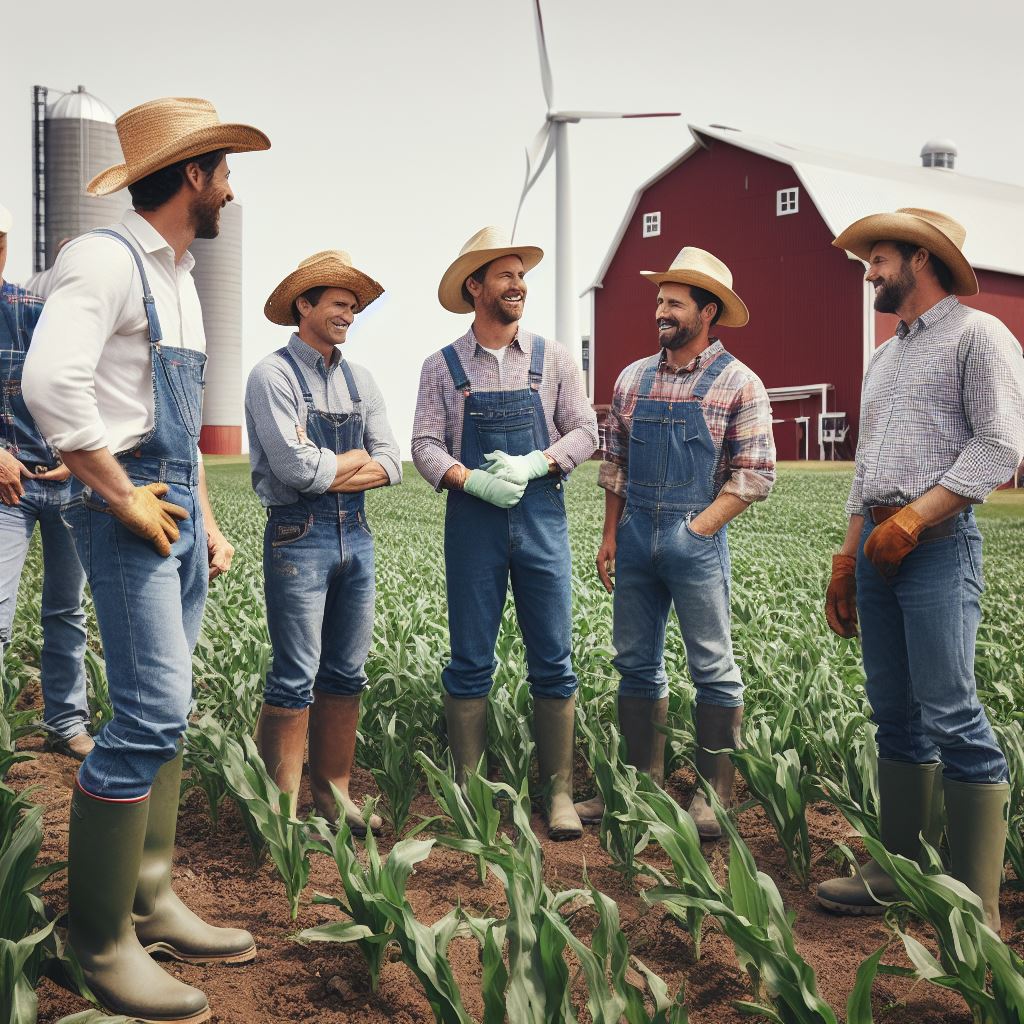Introduction
Agroforestry, the integration of trees and agriculture, promotes sustainable land use and climate-smart farming practices.
Climate-smart farming involves adapting to climate change, mitigating its effects, and ensuring food security.
Agroforestry plays a pivotal role in achieving climate-smart farming by providing multiple benefits such as carbon sequestration and biodiversity preservation.
By combining trees and crops, agroforestry systems enhance soil fertility, water management, and yield stability.
These systems create microclimates, reducing extreme temperatures and wind erosion, thus protecting crops from climate-related risks.
Agroforestry also supports sustainable livelihoods for farmers, diversifying their income through the sale of tree products.
Trees in agroforestry systems capture and store atmospheric carbon, mitigating greenhouse gas emissions and combating climate change.
Moreover, the increased tree cover contributes to cleaner air, improved water quality, and enhanced ecosystem resilience.
Agroforestry promotes biodiversity by providing habitats for wildlife, enhancing ecological balance and promoting natural pest control.
Furthermore, the shade provided by trees reduces the need for irrigation and protects crops from heat stress.
In short, agroforestry is a vital component of a climate-smart farming future, ensuring sustainable agriculture, climate change adaptation, and food security.
Benefits of Agroforestry
Agroforestry is an innovative farming practice that combines the cultivation of trees with traditional agricultural crops or livestock.
This intated approach brings numerous benefits to the environment, farmers, and society as a whole. In this blog section, we will explore the various advantages of agroforestry and how it contributes to a climate-smart farming future.
Enhancing Biodiversity
Agroforestry systems promote biodiversity by creating diverse habitats for various plant and animal species. Here’s how agroforestry enhances biodiversity:
- Increased Habitat Complexity: The combination of trees, crops, and livestock in agroforestry systems provides a range of habitats, attracting a greater diversity of wildlife.
- Niche Creation: Different tree species in agroforestry systems support specific groups of animals, resulting in the coexistence of various species within a farm.
- Wildlife Corridors: Planting trees along field boundaries and streams connects fragmented habitats, facilitating the movement of wildlife and reducing their vulnerability.
Improving Soil Health and Fertility
Agroforestry practices benefit soil health and fertility, leading to sustained agricultural productivity. Here’s how agroforestry improves soil health and fertility:
- Nutrient Cycling: Trees, with their deep roots and leaf litter, enhance nutrient cycling by recycling nutrients back into the soil, making them available to crops.
- Soil Organic Matter: Agroforestry systems contribute to increased organic matter in the soil, improving soil structure, water holding capacity, and nutrient retention.
- Erosion Control: Tree roots bind the soil particles, minimizing erosion caused by wind and water, protecting against soil degradation.
Role of Agroforestry in Carbon Sequestration
Agroforestry plays a significant role in carbon sequestration, contributing to the mitigation of climate change. Here’s how agroforestry helps in carbon sequestration:
- Carbon Storage: Trees in agroforestry systems store carbon in their biomass, contributing to natural carbon sequestration and reducing greenhouse gas emissions.
- Soil Carbon: Agroforestry practices increase organic matter in the soil, leading to the sequestration of carbon dioxide through improved soil carbon stocks.
- Reduced Deforestation: Agroforestry provides economic alternatives that reduce the pressure on forests, preventing deforestation and the release of stored carbon.
Advantages of Agroforestry in Mitigating Climate Change Impacts
Agroforestry offers several advantages in mitigating the impacts of climate change.
Here are the key advantages:
- Climate Resilience: Agroforestry systems are more resilient to climate variability, as the diversity of tree species and crops provides a buffer against extreme weather events.
- Water Conservation: Tree canopies in agroforestry systems reduce water evaporation, increase water infiltration, and enhance groundwater recharge, contributing to better water management.
- Shade and Wind Protection: Trees provide shade to crops, reducing heat stress, and act as windbreaks, minimizing wind erosion and damage caused by strong winds.
Agroforestry presents a promising solution for a climate-smart farming future.
By enhancing biodiversity, improving soil health, sequestering carbon, and mitigating climate change impacts, agroforestry offers a sustainable and resilient approach to agricultural production.
Implementing and promoting agroforestry practices should be encouraged to achieve a more sustainable and climate-resilient agricultural sector.
Read: Greenhouse Gases: Farming’s Role and Solutions
Agroforestry Techniques
Agroforestry is a sustainable farming practice that integrates trees and crops or livestock on the same piece of land.
There are several agroforestry systems that farmers can adopt to improve their land’s productivity and resilience to climate change.
1. Alley Cropping
Alley cropping involves planting rows of trees alongside crops in a systematic arrangement.
Transform Your Agribusiness
Unlock your farm's potential with expert advice tailored to your needs. Get actionable steps that drive real results.
Get StartedThe trees provide shade, windbreak, and improve soil fertility while allowing enough sunlight for the crops.
This technique reduces erosion, facilitates nutrient cycling, and increases biodiversity.
One successful example of alley cropping is the practice of growing cocoa or coffee trees alongside maize or beans.
The shade from the trees protects the crops from extreme temperature and reduces the risk of soil moisture loss.
2. Silvopasture
Silvopasture integrates trees, livestock, and forage in a mutually beneficial system.
Trees provide shade and shelter for livestock, while the animals provide natural fertilizer for the trees.
This technique enhances animal welfare, reduces heat stress, and improves forage quality.
In practice, farmers can combine grass, legumes, or small grains with trees like Grevillea or Leucaena in their pastures.
Livestock, such as cattle or goats, can graze on the forage while benefiting from the shade and shelter provided by the trees.
3. Windbreaks
Windbreaks are rows of trees or shrubs planted along farm boundaries or within fields to protect crops and livestock from strong winds.
They help reduce wind erosion, prevent soil moisture loss, and create microclimates.
Farmers can use windbreaks to shield their crops from wind damage, particularly in regions prone to strong winds.
For example, rows of eucalyptus or pine trees can be strategically placed to reduce wind speed and protect delicate crops like fruits or vegetables.
Successful Agroforestry Implementations
1. Case Study
The Sahel region in Africa faced desertification and soil degradation due to climate change.
Farmers implemented a combination of alley cropping and windbreaks, planting trees like Acacia or Faidherbia albida alongside millet or sorghum.
The results showed increased crop yields, reduced soil erosion, and improved soil quality.
2. Case Study
In Brazil, silvopasture systems have been widely adopted in the Amazon region.
Farmers integrated cattle ranching with tree species like Brazil nut or mahogany.
This practice reduced deforestation, provided sustainable income from both timber and livestock, and preserved the biodiversity of the region.
In essence, agroforestry offers various techniques that promote sustainable and climate-smart farming.
Alley cropping, silvopasture, and windbreaks are just a few examples that provide multiple benefits such as increased agricultural productivity, improved soil health, and reduced environmental degradation.
Learning from successful case studies, farmers can implement these techniques to enhance their resilience to climate change while ensuring food security and environmental sustainability.
Read: Coastal Farms: Rising Sea Levels’ Big Impact

Challenges and Barriers
Potential challenges faced by farmers in adopting agroforestry practices
- Lack of awareness: Many farmers may not be aware of the concept and benefits of agroforestry.
- Limited knowledge and training: Farmers may lack the necessary knowledge and skills to implement agroforestry techniques effectively.
- Upfront costs: Initial investments in agroforestry systems can be high, including purchasing seedlings and equipment.
- Limited access to resources: Farmers may face challenges in accessing suitable tree species, technical support, and financial resources.
- Time and labor-intensive: Agroforestry practices require maintenance and management, which can be time-consuming and physically demanding.
- Lack of market for agroforestry products: Farmers may hesitate to adopt agroforestry if there is a lack of demand and market for the products generated.
Misconceptions or myths surrounding agroforestry:
- Reduced crop productivity: Some farmers believe that integrating trees with crops may hinder crop growth and reduce yields.
- Tree competition for resources: There is a misconception that trees compete with crops for nutrients, water, and sunlight.
- Complexity and risk: Farmers may perceive agroforestry systems as too complicated and risky to implement and manage effectively.
- Lack of profitability: Some farmers believe that agroforestry practices may not be as profitable as conventional farming methods.
- Long-term commitment: Farmers may view agroforestry as a long-term commitment, and this might discourage those who prefer shorter-term gains.
The need for policy support and financial incentives to overcome barriers:
- Promoting agroforestry in agricultural policies: Governments and policymakers should recognize the benefits of agroforestry and include it in agricultural policies and programs.
- Providing technical assistance and training: Governments and agricultural institutions should offer training programs and technical support to assist farmers in adopting agroforestry practices.
- Financial incentives and subsidies: Governments can provide financial incentives and subsidies to encourage farmers to invest in agroforestry systems.
- Establishing market linkages: Governments and organizations can help farmers by facilitating market linkages and creating demand for agroforestry products.
- Information dissemination: Efforts should be made to raise awareness about agroforestry among farmers through extension services, workshops, and educational campaigns.
Basically, while agroforestry offers numerous environmental and socio-economic benefits, there are several challenges and barriers that farmers may face in adopting these practices.
Showcase Your Farming Business
Publish your professional farming services profile on our blog for a one-time fee of $200 and reach a dedicated audience of farmers and agribusiness owners.
Publish Your ProfileLack of awareness and limited access to resources, along with misconceptions about agroforestry, can hinder its widespread adoption.
However, with the right policy support, financial incentives, and increased awareness, these barriers can be overcome, leading to a climate-smart farming future powered by agroforestry.
Read: Climate’s Toll on Soil: Farming’s Unsung Hero
Delve into the Subject: CRISPR Crops: Answer to Climate Woes?
Successful Agroforestry Examples
Agroforestry has been proven to be beneficial for both farmers and the environment.
Here are some real-life success stories of farmers who have implemented agroforestry:
- John’s Fruit Farm: John, a small-scale farmer, decided to incorporate agroforestry into his fruit farm.
- Experiences and Challenges: Initially, John faced challenges such as limited knowledge and financial resources to start.
- Outcomes: With guidance from agricultural experts, John successfully established a diverse orchard with trees providing shade.
- Positive Impact: Agroforestry helped John increase his farm’s productivity by creating a microclimate favorable for fruit production.
- Sarah’s Agroforestry System: Sarah, a farmer in a drought-prone area, adopted agroforestry to combat water scarcity.
- Experiences and Challenges: Sarah initially faced difficulties in choosing suitable tree species and managing water efficiently.
- Outcomes: By integrating nitrogen-fixing trees into her system, Sarah improved soil fertility and reduced water usage.
- Positive Impact: Agroforestry helped Sarah mitigate the effects of drought, ensuring a stable income for her family.
- Carlos’ Agroforestry Model: Carlos, a coffee farmer, implemented agroforestry to optimize his crop yield and preserve the ecosystem.
- Experiences and Challenges: Carlos faced resistance from traditional coffee growers and encountered difficulties in pruning and tree management.
- Outcomes: By planting shade trees, Carlos increased biodiversity on his farm, attracting natural pest predators.
- Positive Impact: Agroforestry improved coffee quality, reduced the need for chemical inputs, and preserved wildlife habitats.
These success stories illustrate the positive impact of agroforestry on farmers’ livelihoods and the environment.
By implementing agroforestry practices, farmers can diversify their income sources, increase productivity, and improve environmental sustainability.
Read: Innovative Crops: Beating Climate Heat & Drought
Agroforestry and Climate Change Adaptation
Agroforestry is an innovative farming approach that can have a significant impact on climate change adaptation.
By combining trees and crops on the same piece of land, farmers can enhance their resilience to the challenges posed by a changing climate.
Here are some key ways in which agroforestry can help farmers adapt:
1. Enhanced Soil and Water Management
- Agroforestry systems provide added tree roots, which help improve soil structure and reduce erosion.
- The presence of trees also enhances water infiltration and reduces run-off, ensuring better water retention.
- This improved soil and water management helps farmers cope with extreme weather events like heavy rainfall or droughts.
2. Increased Biodiversity and Biological Pest Control
- Agroforestry systems create a diverse environment that supports a wide range of plant and animal species.
- This biodiversity helps in natural pest control, reducing the need for harmful chemical pesticides.
- By promoting a balanced ecosystem, agroforestry minimizes the impact of climate-related pest outbreaks on crops.
3. Carbon Sequestration and Climate Regulation
- Trees play a vital role in capturing and storing carbon dioxide, a major greenhouse gas responsible for climate change.
- Agroforestry systems sequester significant amounts of carbon, helping mitigate climate change.
- Furthermore, trees provide shade and windbreaks, reducing the impact of extreme temperatures and wind gusts.
4. Diversified Income Opportunities
- Agroforestry allows farmers to diversify their income sources by cultivating a variety of tree crops, fruits, and herbs alongside traditional crops.
- These additional income streams provide economic resilience, particularly during crop failures or market fluctuations.
- Agroforestry also offers opportunities for value addition through processing and marketing of tree products
5. Conservation of Natural Resources
- Agroforestry contributes to the conservation of natural resources by reducing deforestation and promoting sustainable land use practices.
- By avoiding clear-cutting, farmers maintain forest cover and preserve habitats for wildlife.
- Proper tree management and maintenance also prevent soil degradation and promote long-term productivity.
6. Social and Cultural Benefits
- Agroforestry systems provide multiple social and cultural benefits to farmers and their communities.
- These systems often involve traditional knowledge and practices, connecting generations and preserving cultural heritage.
- The sense of ownership in managing diverse farm resources enhances community cohesion and reduces conflicts over land.
Agroforestry offers a promising pathway for farmers to adapt to the challenges of climate change.
By integrating trees within their fields, farmers can enhance resilience, diversify income, and contribute to climate change mitigation.
As the world continues to grapple with the impacts of climate change, agroforestry emerges as a climate-smart farming practice capable of building sustainable and resilient agricultural systems.
Conclusion
Agroforestry offers numerous benefits for a climate-smart farming future.
It helps combat climate change, improves soil health, increases biodiversity, and provides economic opportunities for farmers.
The widespread adoption of agroforestry practices is crucial to ensure sustainable food production and mitigate the effects of climate change.
It is imperative for individuals, communities, and governments to support and promote agroforestry initiatives.
By learning more about agroforestry and actively supporting its implementation, we can contribute to a more sustainable and resilient agricultural system.
Together, let us embrace agroforestry as a solution for a climate-smart farming future.




